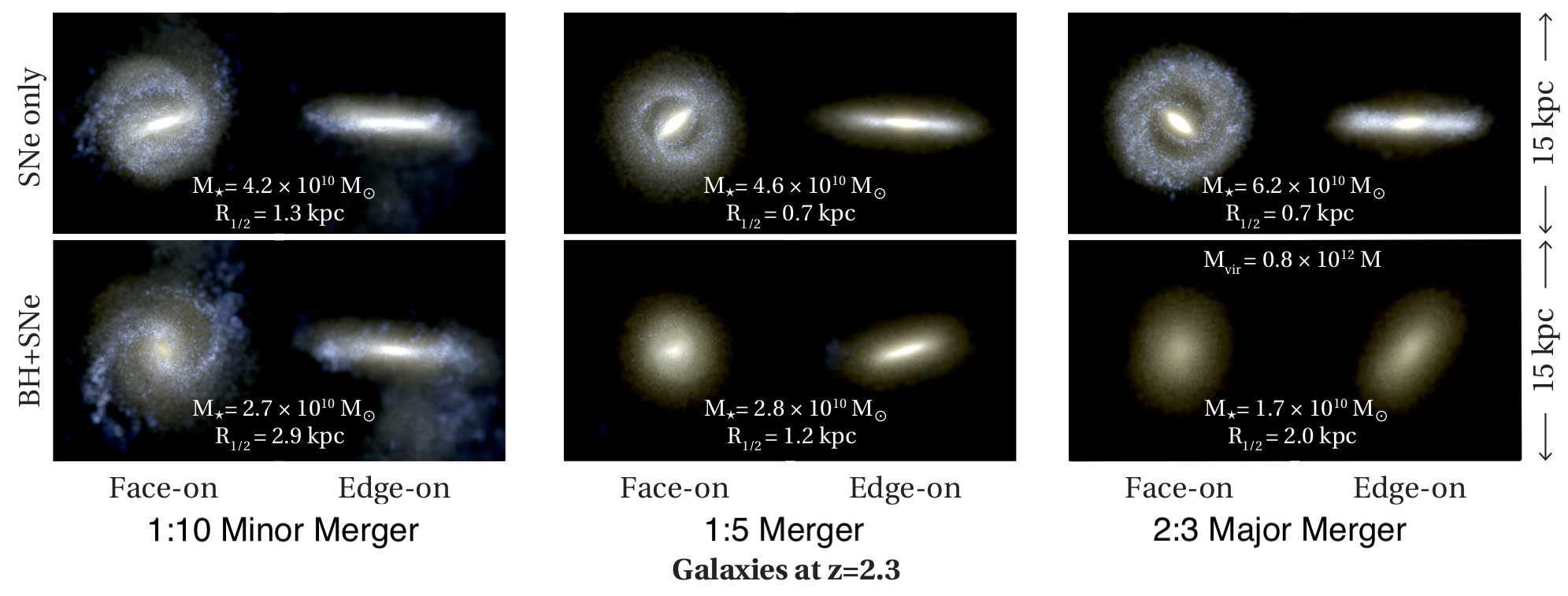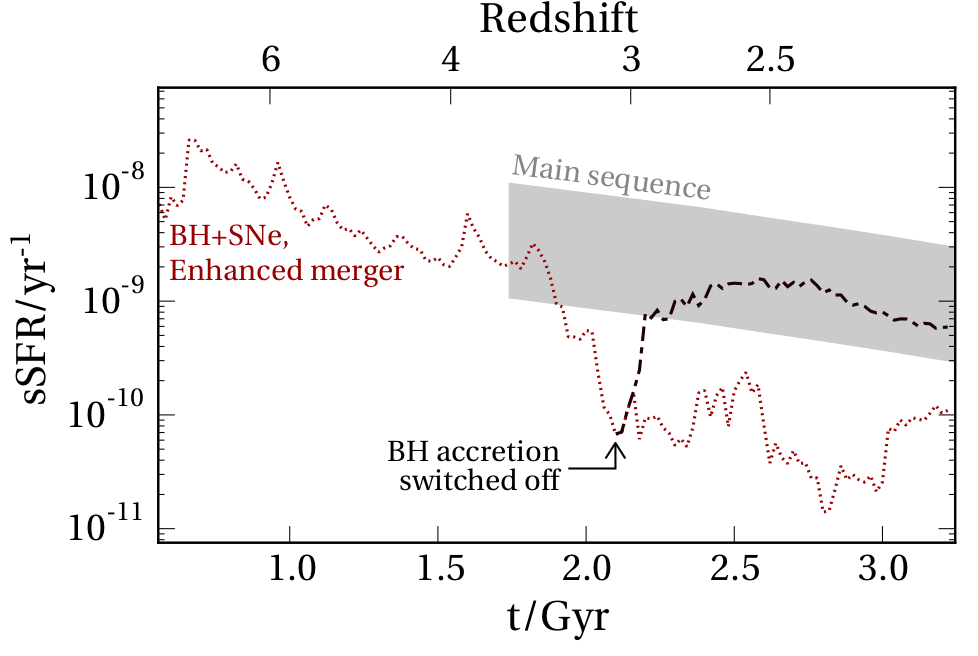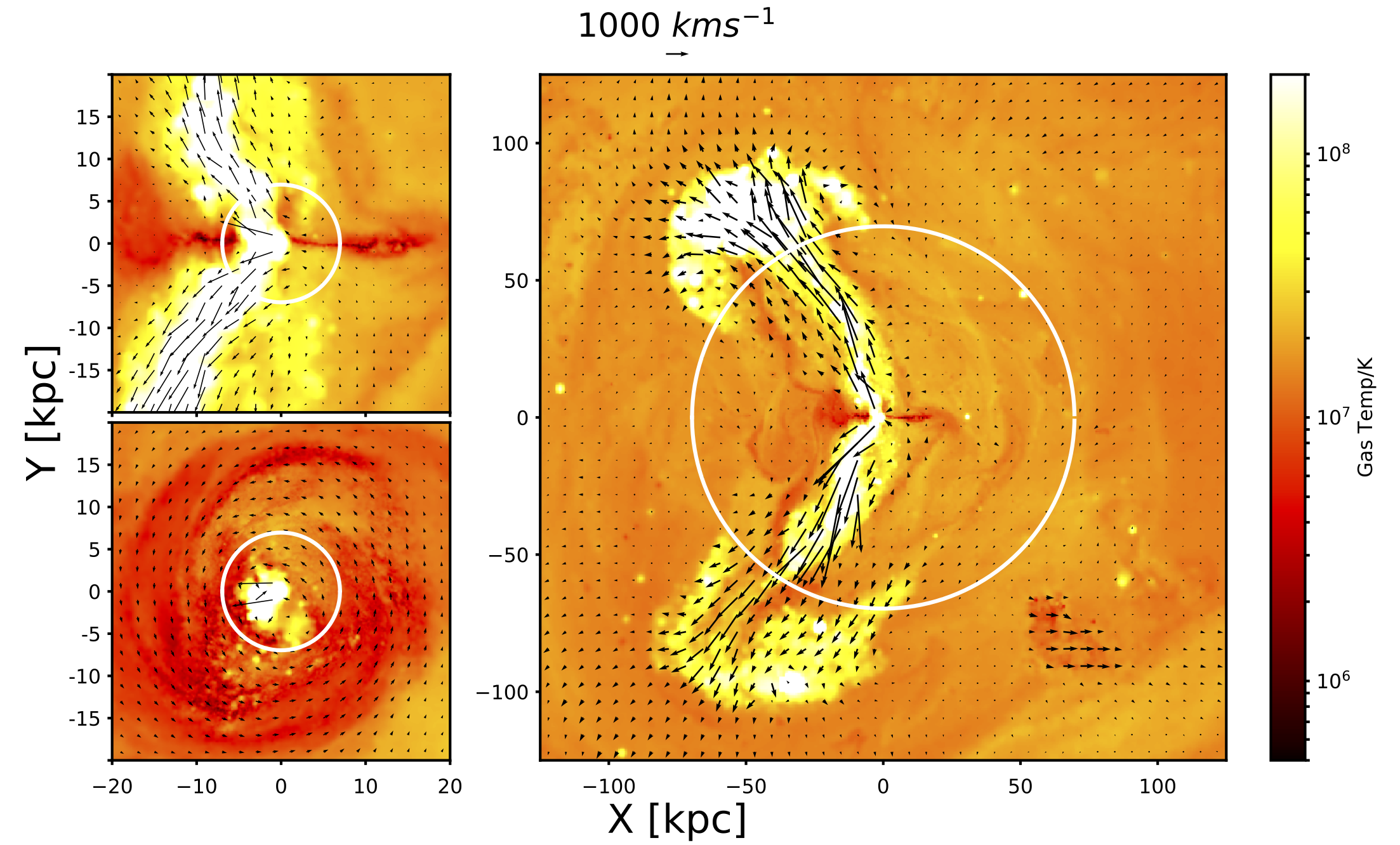AGN Feedback and Galaxy Quenching
When and where do SMBHs grow and how do they affect their host galaxies?
Overview
Accreting nearby gas is how supermassive black holes (SMBHs) are thought to gain most of their mass. As this occurs, the gas that is feeding the SMBH generates an enormous amount of energy. It is this energy that we often see in the form of active galactic Nuclei (AGN), or the bright central regions of a galaxy. Not only does this energy help us "see" these SMBHs (indirectly, at least) and even infer some of their properties like their mass, energy from AGN can affect the gas in their host galaxies. Using cosmological simulations like Romulus, I am working in collaboration with Tom Quinn , Andrew Pontzen (University College London), Marta Volonteri (Institut d'Astrophysique de Paris), Daisuke Nagai (Yale), Arif Babul (U of Victoria), and Urmila Chadayammuri (Yale) to better understand how this feedback acts to regulate and sometimes quench star formation in massive galaxies.
AGN Feedback and Major Mergers
It has long been thought that mergers between massive galaxies result in a large amount of SMBH growth. It is also thought, due to the different morphologies of galaxies, that quenching may also be related to such mergers. Utilizing a new technique called Galaxy Genetic Modification, developed by Nina Roth, Andrew Pontzen, and others, we are able to conduct controlled experiments with cosmological simulations. We can take a galaxy and manipulate aspects of its formation history in different ways. In the first science application of this technique, we run a series of simulations of the same massive, high redshift galaxy where we manipulate a merger event to be more minor or more major relative to the original.

Using these simulations, we found that major mergers play an important role in determining the star formation history of massive, high redshift galaxies. In particular, major mergers result in quenching while more minor mergers allow star formation to continue unimpeded. This effect, however, requires feedback from AGN. Without it, the galaxy doesn't care much about the details of its merger history. Following major mergers, large-scale outflows driven by AGN result in the quenching of star formation.

We also find that AGN feedback is important not only for initiating quenching, but also in maintaining it. If the SMBH were shut off after the galaxy in the major merger quenches, we find that the galaxy quickly reforms its gaseous disk and becomes happily star formining.
Galaxy Quenching and AGN Feedback "In The Wild"
While the above study helped us better understand the process of quenching and the potential interaction between SMBHs and galaxy mergers that may be required, we want to further test this idea across a range of cosmic epochs and galaxy masses using the Romulus Simulations. We will test and develop a more general theory of when and why galaxies cease to form stars (and when they may start up again once they quench).
Regulating Star Formation in The Most Massive Galaxies
The most massive galaxies in the Universe exist at the centers of galaxy clusters, otherwise known as brightest cluster galaxies (BCGs). These galaxies are generally observed to have relatively little star formation. However, simple estimates based on the cooling of gas in the cores of clusters would indicate that the star formation rates should be orders of magnitude higher than observed. With the RomulusC simulation, we are studying how AGN feedback regulates star formation in these extreme environments with more detail than ever before.

Thanks to the high resolution of RomulusC, our very simple feedback model is able to drive powerful, columnated winds that extend out to large distances. This is the first time that such outflows have been predicted by a cosmological simulation without explicitly assuming they exist.
When and Why Does AGN Feedback Quench Star Formation?
Utilizing the high resolution in both Romulus25 and RomulusC, I am working to better understand the physical process of quenching star formation. Using the BCG in RomulusC as an initial test case, I am working in collaboration with Umila Chadayammuri and Daisuke Nagai to understand the evolution of AGN winds and how they affect gas on large scales. We will then apply these ideas to a broader sample of massive galaxies in Romulus25, as well as future simulations.
AGN-Driven Outflows and the Circum-Galactic Medium
Using both genetically modified galaxies and the Romulus25 uniform volume simulation, I am studying the connection between AGN feedback, large-scale outflows, and the structure of the CGM in galaxies across cosmic time. This work is being done in collaboration with Nicole Sanchez (U of Washington), who is leading much of this work, and Jessica Werk (UW)
AGN growth in dwarf galaxies
In Romulus, SMBHs are seeded in small galaxies in the early Universe and some still exist in small galaxies at z = 0. In collaboration with Jillian Bellovary (Queensborough), Anna Wright (Rutgers), Ramon Sharma (Rutgers), Alyson Brooks (Rutgers), and Ferah Munshi (Oklahoma), we are examining the growth of SMBHs in dwarf galaxies, whether SMBHs have a noticeable effect on dwarf galaxy evolution, and how we might detect their presence either electromagnetically or through gravitational waves.
© 2018 Michael Tremmel | Based on the template design by Andreas Viklund